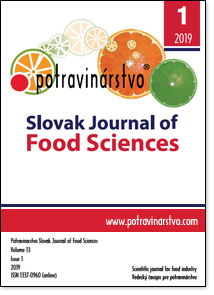Researching of the concentration distribution of soluble layers when mixed in the weight condition
DOI:
https://doi.org/10.5219/1129Keywords:
dough, injection, thermal conductivity, distribution of heat, heat flux, roll, phase, environmentAbstract
The analytical and experimental analysis of the processes associated with the formation of structural systems, which includes adsorption, its main paths of formation, patterns of influence on the structure of the environment and its behavior at deformation influences is carried out. The ways of choosing the optimal variant of the adsorption diffusion process for providing the maximum or minimum value of parameters (criterion) are proposed. The physical essence of the relation of the length of the sorbent layer with the time of its protective action (number of bound substance) is considered, which allows to practically characterize the work of the sorbent layer under dynamic conditions. It is noted that the determination of dynamic combined power flow influences during the process of mixing of components plays an important role in the structure formation of the suspension and promotes the construction of calculations for the construction of mixing equipment. The obtained data give an answer a series of questions about the theory of adsorption and diffusion (adsorption actions of van der Walsh forces on surfaces) and the ability to regulate the effect of combined power flows directly affect these process transformations (concentrations). For a illustration and understanding of the general execution of research, depending on the method of applying force, the degree of its previous dispersion and its physical and mechanical properties, a scheme of causal relationships between components and parameters that determine the change in the structure of the components in mixing process on a new discrete machine. The principle of discrete-momentum mixing of components in the weight condition and mechanical influence of the formable working body is considered. Based on the process of mixing the components in the working chamber of the machine, a mathematical model is proposed.
Downloads
Metrics
References
Braginsky, L. N., Begachev, V. I., Barabash, V. М. 1984. Stirring in liquid media: Physical bases and engineering calculation methods. L. Chemistry, 336 р.
Dolomakin, Y. 2015. Influence of humidity on structural and mechanical characteristics of liquid wheat flour."Modern trends of technology and mechanization of processes of processing and food industries". Bulletin of the Kharkov National Technical University of Agriculture named after Petr Vasilenko. Kharkiv, 166 p.
Drobot, V. I. 2010. Technological calculations in baking production.Condor, 440 p.
Keltsev, N. V. 1984. Fundamentals of adsorption technology. Chemistry, 592 p.
Levich, G. 1952. Physico-chemical hydrodynamics. AN USSR, 135р.
Lykov, A. V. 1954. Transport phenomena in capillary-porous bodies. Gostekhizdat, 305р.
Neuvazhaev, V. E. 2000. Mathematical modeling of turbulent displacement, Izdet of Chelyabinsk University, 135 p.
Pawel D., Derkach A., Stadnyk I., Vitenko T. 2016. Simulation of components mixing in order to determine rational parameters of working bodies. Advances in Science and Technology Research Journal, vol. 9, p. 130-138. https://doi.org/10.12913/22998624/64068 DOI: https://doi.org/10.12913/22998624/64068
Pirogov, A. N.,Leonov, A., Shilov, A. 2008. Rheological properties of raw materials, semi-finished products and finished products of bakery, macaroni and confectionery manufactures.164 p.
Scram, G. 2003. Fundamentals of Practical Rheology and Rheometer. 312 p.
Sekundov, A. 1977. Phenomenological model and experimental study of turbulence in the presence of density pulsation. ANSeconds - Moscow: Science.
Strenk, F. 1971. Mieszanieimieszalniki (Mixing and mixingequipment). Wydawnictwa Naukowo-Techniczne, Warszawa, 367 р. (In Polish)
Zvyagin, V. G., Vorotnikov, D. A. 2004. Mathematical models of non-Newtonian fluids. Voronezh, VSU, 43 p.
Published
How to Cite
Issue
Section
License
This license permits non-commercial re-use, distribution, and reproduction in any medium, provided the original work is properly cited, and is not altered, transformed, or built upon in any way.






























